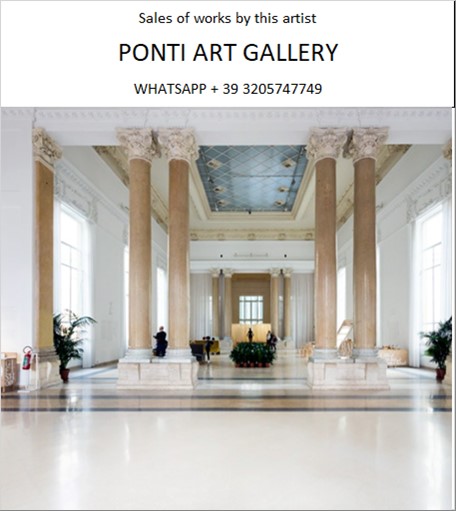Ponti Art Gallery is interested in buying and selling works
of art by this artist.

Frederick-Carl Frieseke
Biography
Frederick Carl Frieseke was an American painter renowned for his role in the American Impressionist movement. Born on April 7, 1874, in Owosso, Michigan, Frieseke's journey into the world of art began against the backdrop of a humble Midwestern upbringing. His grandparents had emigrated from Pritzerbe, Germany, and settled in Owosso, where his father, Herman Carl Frieseke, established a brick manufacturing business. Tragedy struck early in Frederick's life when his mother, Eva Graham, passed away in 1880, leaving him motherless at the tender age of six. The family subsequently moved to Jacksonville, Florida, where Herman started another brick business. This period in Florida would leave a lasting impression on Frederick and later influence his artistic choices.
From a young age, Frieseke displayed a keen interest in the arts, a passion that was encouraged by his grandmother, Valetta Gould Graham, who herself enjoyed painting. His artistic inclinations were further stimulated by a visit to the World's Columbian Exposition in Chicago in 1893. Following his graduation from Owosso High School that same year, Frieseke pursued formal art education at the Art Institute of Chicago, where he studied under Frederick Warren Freer and John Vanderpoel. In 1895, he moved to New York to continue his studies at the Art Students League.
Frieseke's artistic aspirations eventually led him to Paris in 1898, a city that was the epicenter of the art world at the time. He enrolled at the Académie Julian, where he was taught by Jean Joseph Benjamin Constant and Jean Paul Laurens. His time in Paris also brought him into contact with James McNeill Whistler, whose influence on Frieseke's work was profound, particularly in the "infinite gradation" of colors. Whistler's aesthetic principles, along with the popular Art Nouveau movement, shaped Frieseke's early artistic development.
In Paris, Frieseke found success with his nude paintings and city views, and in 1904, one of his works was purchased by the French government. Around the turn of the century, Frieseke and his wife moved to Giverny, a small town that had become a hub for American artists, including Guy Rose, Lawton Parker, Edmund Greacen, and Richard Edward Miller. Giverny was also home to Claude Monet, whose estate neighbored Frieseke's residence. Despite this proximity, Frieseke was more influenced by Pierre Auguste Renoir than Monet, and his work began to reflect the bright, broken brushstrokes of Impressionism.
Frieseke's favorite subjects were female figures set against the backdrop of colorful garden surroundings. His palette in Giverny was dominated by greens, blues, lilacs, iridescent golds, oranges, and creamy whites, capturing the radiant summer sunlight. However, after leaving Giverny for Normandy, his color palette darkened, and he developed an interest in light-dark contrasts, often painting female portraits, including his daughter Frances.
Throughout his career, Frieseke was recognized with numerous awards and honors, including a silver medal at the Louisiana Purchase Exposition in 1904, a gold medal at the Munich Exposition the same year, and the Grand Prize at the Panama–Pacific International Exposition in 1915. He was also made a Chevalier of the French Legion of Honour in 1920. His work was exhibited widely in both the United States and France, and he was a member of the National Academy of Design.
Despite his success, Frieseke's work fell out of favor after his death on August 24, 1939, in Le Mesnil-sur-Blangy, Normandy, France. His paintings were seen as conservative and outmoded, focusing on "pretty women" at a time when the art world was moving towards modernism. However, interest in American Impressionism resurged in the 1960s, and with it, a renewed appreciation for Frieseke's contribution to the movement.
Frieseke's legacy is that of an artist who captured the interplay of light and color with a distinctive American sensibility. His paintings, often featuring women in repose, bathed in sunlight, and surrounded by nature, continue to be celebrated for their beauty and technical mastery. His work remains a testament to the enduring appeal of Impressionism and its ability to evoke the simple pleasures of life.
Frederick-Carl Frieseke Quotes
and Sales of Works
Ponti Art Gallery selects and deals with paintings by the
artist. Upon request, we provide free estimates and
evaluations, communicate prices, quotations, and current
market values.
If you are interested in BUYING or SELLING works by the
artist, contact us immediately.
If you wish to sell or receive an evaluation of the
works:
Send us a frontal photo of the painting, one of the back,
and one of the signature. Also, indicate the dimensions of
the work. Inform us about the purchase origin of the work
and any kind of available documentation (purchase
receipts, certificates of authenticity, publications). One
of our operators will respond to you on the same day. We
guarantee maximum confidentiality and extreme
professionalism.
If you wish to purchase works by the painter: Contact us
and let us know your request. We will inform you about the
available works. We also offer the possibility to
subscribe to our NEWSLETTER, through which you will be
informed at the beginning of each month about the latest
acquisitions of the art gallery.
You can send us pictures of the work:
